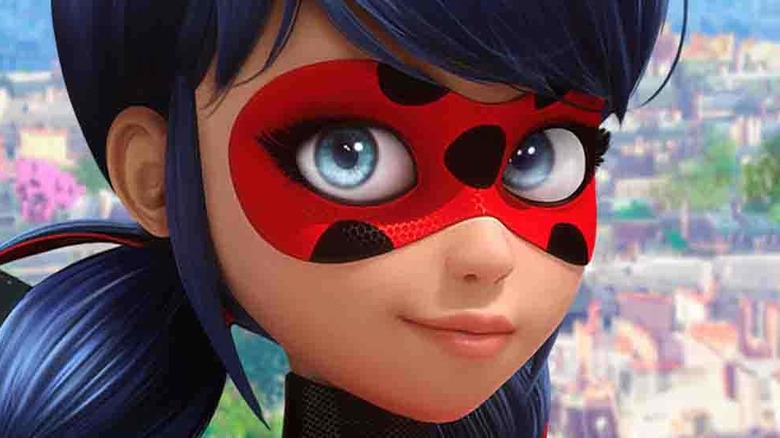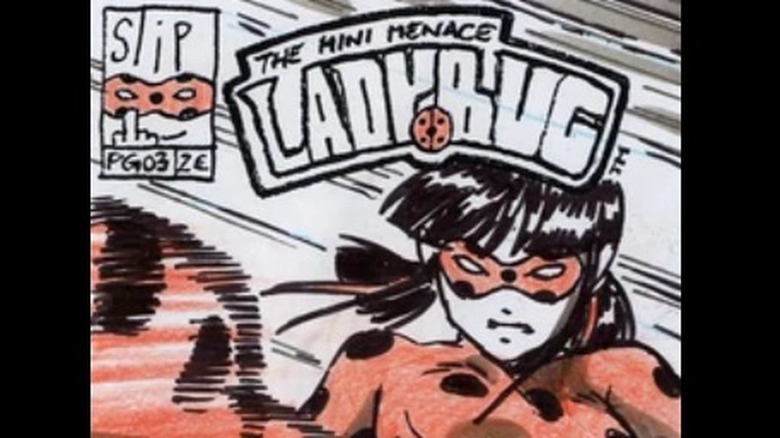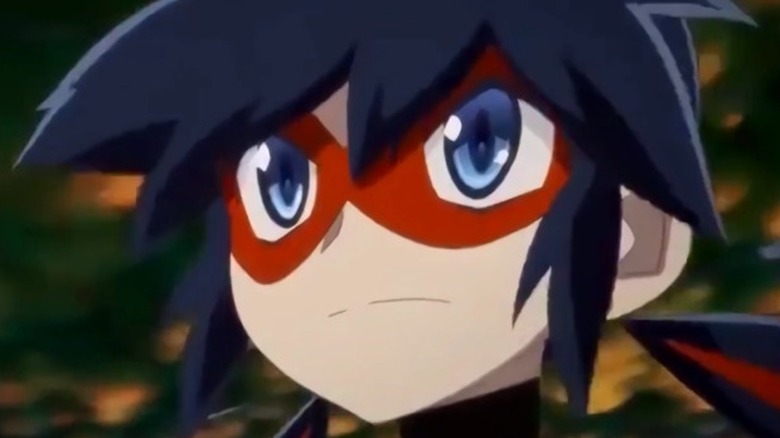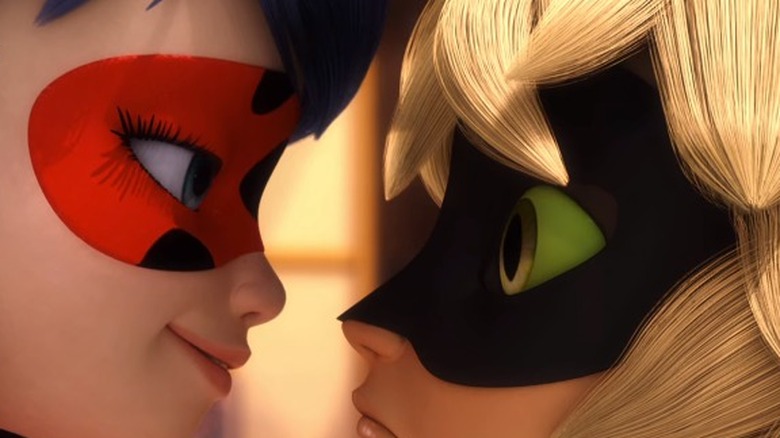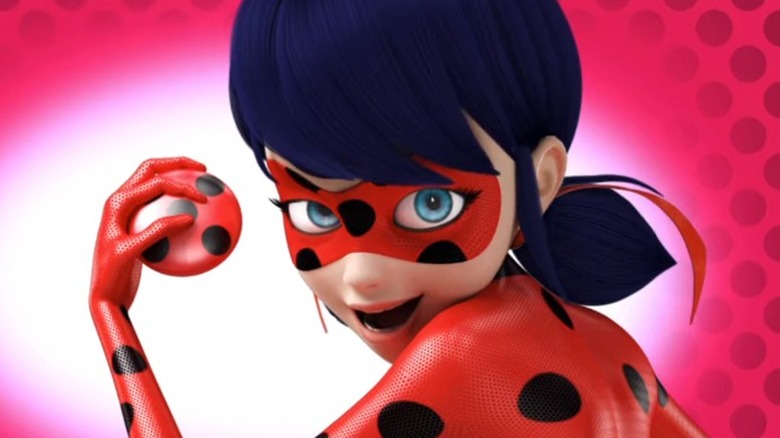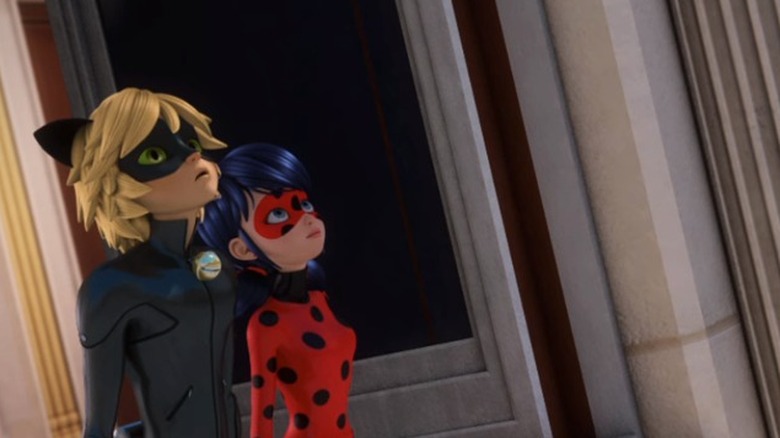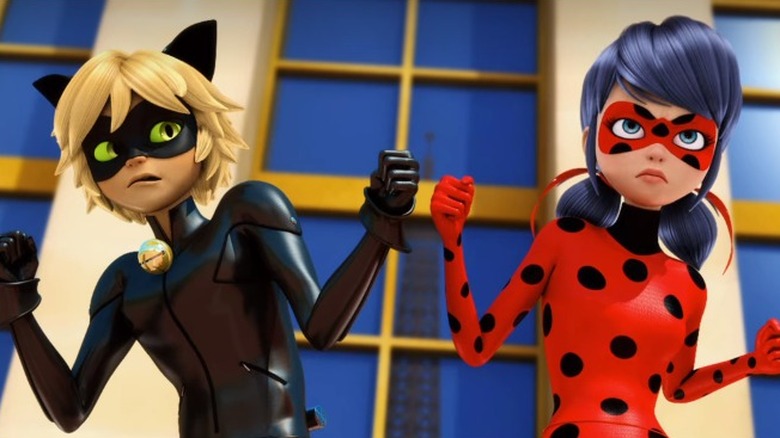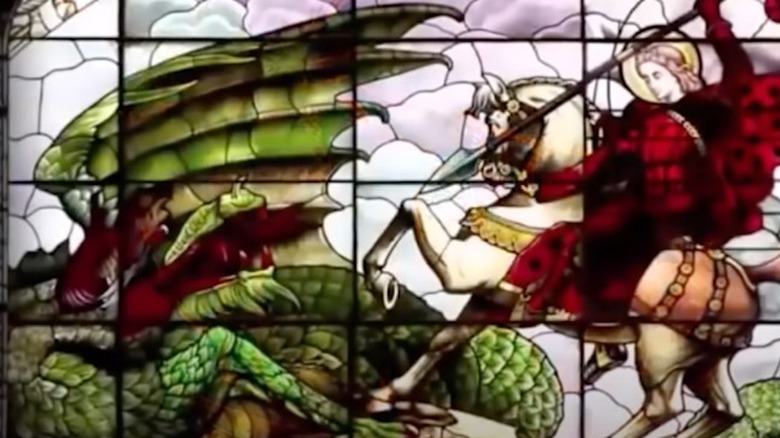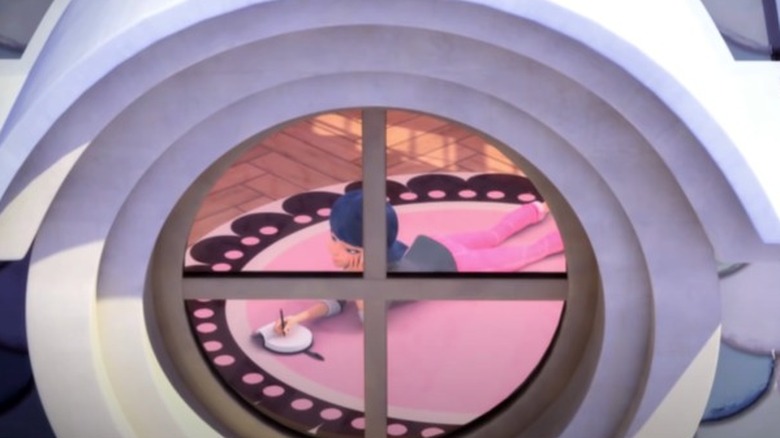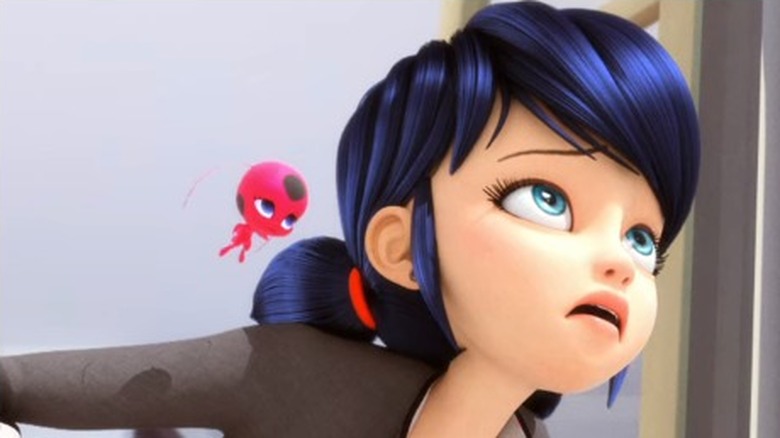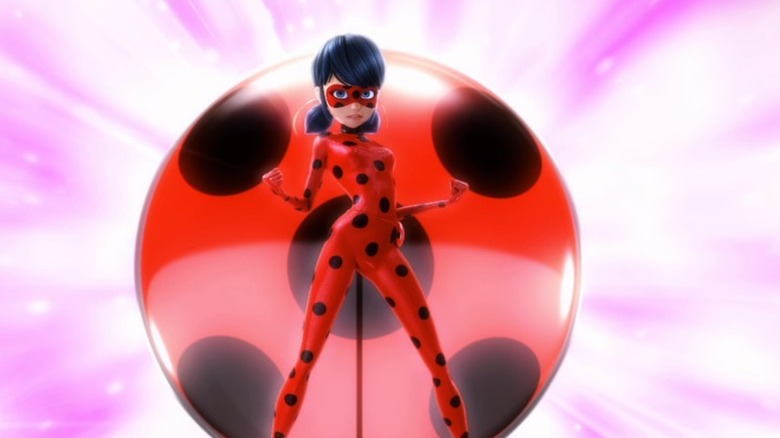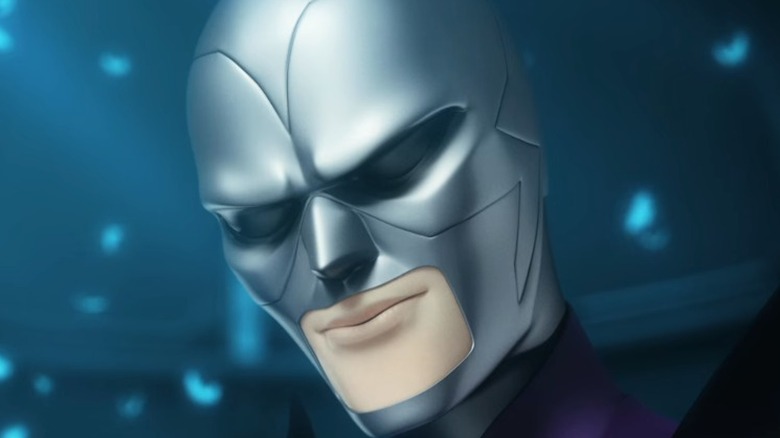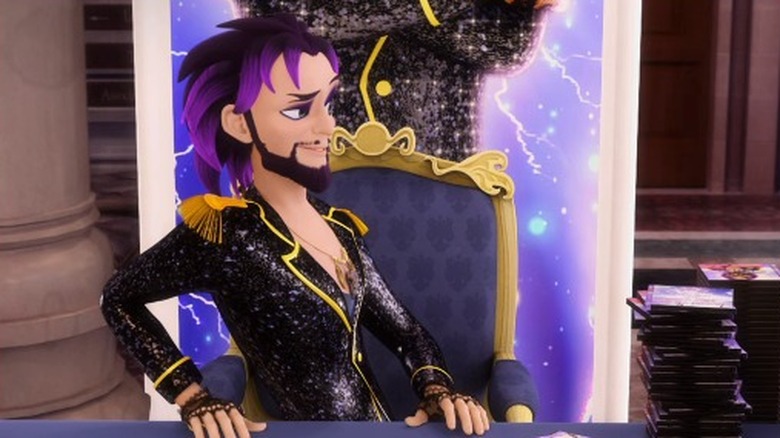The Untold Truth Of Miraculous: Tales Of Ladybug And Cat Noir
The dynamic superhero duo of Ladybug and Cat Noir have been fighting crime and defending Paris for more than 100 episodes of "Miraculous: Tales of Ladybug and Cat Noir." Though Ladybug and Cat Noir are known throughout France as powerful superheroes, when they're not fighting crime, they are Marinette Dupain-Cheng and Adrien Agreste — two teenagers who attend the same school and are unaware of each other's secret identities. As Cat Noir, Adrien is in love with Ladybug. As Marinette, Ladybug is in love with Adrien. Neither of them know the truth. But they don't have much time for romance as they battle their biggest villain, Hawk Moth, who uses his butterflies to Akumatize the citizens of Paris to become villains that battle Ladybug and Cat Noir while attempting to take away their jewels, known as their "Miraculouses," that give them their powers.
Since its debut in 2015, the show has drawn in quite an audience, with both younger generations and older generations alike enjoying the content. Originally broadcast in multiple languages on an international scale, the series has arrived on streaming platforms for anyone who wants to catch up in preparation for the upcoming seasons and beyond. Though you might be familiar with the show, there are a lot of hidden details you might not know about yet. Read on for the untold truth of "Miraculous: Tales of Ladybug and Cat Noir."
It was originally going to be a comic
In many interviews, Thomas Astruc, the creator of "Miraculous: Tales of Ladybug and Cat Noir" has talked about how his original intention was to make a superhero comic that rivaled those like "The Amazing Spider-Man" and others. Astruc saw the need for a Ladybug hero when he saw his co-worker wearing a ladybug t-shirt. He'd never seen any other ladybug superheroes — only spiders, wasps, ants, and some others.
Initially, the comic was called "The Mini Menace Ladybug" and based on early designs made by Astruc. It was going to be a traditional superhero comic with darker themes that explored the life of Marinette, who was originally named Marietta. It would combine the classic Japanese style of drawing with superhero comics Astruc loved and would feature a variation of Cat Noir that was being conceived while Astruc came up with the concept art for Ladybug. One of the issues even has a supposed homage to an issue of "The Amazing Spider-Man" called "Spider-Man No More!" where Peter walks away from superhero duties. This parallel can be seen on "The Mini Menace Ladybug" fandom page, where the creator cites the similarities and the covers.
The show didn't always use 3D animation
"Miraculous: Tales of Ladybug and Cat Noir" is shot in a 3D style that uses CG animation. While this animation style is very time consuming to create, it also allows for "Miraculous" to include the kinds of action sequences you'd typically expect from a live action superhero production.
Though this approach is what the animators ended up going with, the 3D CG style wasn't always the plan. Initially, the show was looking to do a traditional Japanese manga style like the original comic book concept art. This style calls for 2D animation with more traditional looking characters that aren't as dynamic but have a very unique style. In an interview, creator Thomas Astruc talked about how there were some concerns regarding marketability for the 2D animated-manga style in France and the United States. As a result, they sought out the 3D CG style that the team felt would land better with audiences.
It's not just a superhero show – it's a sitcom
When fans think of this show, the action and superhero elements are typically the first to come to mind. At its heart, "Miraculous: Tales of Ladybug and Cat Noir" is a superhero saga that follows two people trying to navigate their secret identities and keep their city safe. However, like some superhero productions, there's a comedic element that makes the characters relatable to the audience. The creators try to incorporate two genres into every episode. In some ways, the series is half a sitcom where you see the everyday lives of the teenagers and half an action show where the camera is always moving through exciting high-stakes fights.
The first half of the episodes typically have the characters struggle with their teenage identities. Marinette will usually spiral about something related to fashion or Adrien, while Adrien will deal with his paradoxical loneliness at home and popularity at school. The teenagers face funny situations that young people watching are going through or older people watching have been through; it's very quirky and relatable. In the second half of the episode, though, the intensity comes out. Marinette and Adrien's real-life problems go on pause as they transform into Ladybug and Cat Noir and only care about saving the people of Paris from impending doom. The kinetic mix of the two elements together keep the show from ever producing a moment of dullness.
The show aired in South Korea before anywhere else
Though Thomas Astruc and collaborator Wilfried Pain are French, they wanted to market their show to an American audience as well as French viewers. Many different animation companies work together to create the compelling story, dynamic animation, the closed captioning, and dubs of the voiceovers for "Miraculous: Tales of Ladybug and Cat Noir."
Because of the creators' French roots, it would only make sense for the show to air first in France, right? However, before it premiered in France in October 2015, the series first aired in South Korea in September 2015 on the network EBS1. It's likely that South Korea, where a few companies involved in the production are based, was the de facto test audience for the show. It makes sense, especially because of the show's roots in manga and the fact that Japanese magic girl genre programs tend to do well with Asian audiences. However, France and the United States became the primary countries for the show's broadcast, with other countries using mostly video on demand or streaming services to watch the superheroes.
There are three main dubs with different casts
Because "Miraculous: Tales of Ladybug and Cat Noir" is marketed toward French, Japanese, and American audiences, there are naturally language barriers to consider. Typically, when shows have language dubs, the casts are different because hiring actors capable of speaking every language needed would be very, very difficult. There are three separate casts of dubs, each for their respective language: French, Japanese, and English. For Cat Noir, Benjamin Bollen takes the French dub, Ryōta Ōsaka performs the Japanese dub, and Bryce Papenbrook voices the English dub. For Ladybug and Marinette, Anouck Hautbois does the French dub, Karin Nanami performs the Japanese dub, and Cristina Vee takes on the English dub.
As the English dub for Ladybug and Marinette, Vee identifies a lot with the role. It's not her first big voice role, as she's been in shows like "Hunter x Hunter" and "High-Rise Invasion," but it is one she feels very passionately about. In an interview with Lindalee Rose (via YouTube), Vee said, "I'm a lot like Marinette in real life. I can be pretty shy and clumsy. I trip over my words and feet, both things. When I first read the sides for the audition script, I was like, 'Oh my gosh, she's me. This is me on paper!'"
Ladybug and Cat Noir are good and bad luck
Ladybug and Cat Noir mirror each other in a lot of ways. Cat Noir is much more playful and flirtatious, whereas Ladybug is more serious and focused on the mission at hand. Ladybug has a much lighter and kinder energy, whereas Cat Noir has a more mysterious and dark energy. These two creatures are almost direct foils to each other in every sense. The Ladybug Miraculous and the Cat Noir Miraculous are yin and yang. This is intentional.
Ladybugs, according to legend and the South Carolina Aquarium website, are meant to be symbols and possessions of good luck. Some people believe a ladybug's spots have to deal with how many years of good luck you have or the months you have until your dreams come true. It's also just general good luck when a ladybug lands on you. Ladybug has her lucky charm that she uses as her secret weapon, which is a reference to her namesake's connection with good fortune.
Black cats, according to legend and History.com, are meant to symbolize bad luck. In the real world, black cats don't really impact luck one way or another but often make excellent pets. But Cat Noir is bad luck for the criminals of Paris; his cataclysm weapon directly references the word "cataclysm," which means a hugely violent occurrence.
The Miraculouses and Kwamis have been around a long time
The Miraculouses are the jewels that the superheroes wear, and their Kwamis are spirit beings who embody the superhero traits that enhance the human they're paired with. Though "Miraculous: Tales of Ladybug and Cat Noir" is set in the present-day Paris, the Miraculouses and Kwamis have been around much longer than that. Tikki was first, as Tikki is the Kwami of creation. As new concepts were invented and introduced to the world, new Kwamis were born. The Kwami origins are explained in Season 1, including how Plagg used a cataclysm to rid the world of dinosaurs.
The Kwamis obviously date far back, and the "Origins" episodes give good context to help fans understand how Kwamis work and how they've evolved over the years. There's also some context as to who wields Kwamis, and fans speculate that Saint George was one ancient Kwami wielder. This is because of a shot of a stained-glass window of Saint George that, in the show, shows him wielding a Kwami. While that's a small fun fact, it's very interesting to think about how Kwamis might affect global history in the world of "Miraculous."
The webisodes reveal some secrets
Though most hardcore fans of "Miraculous: Tales of Ladybug and Cat Noir" will know this, for those who do not, the show not only comes out on television, but through webisodes. The Miraculous Ladybug YouTube page includes many webisodes to give the audience more Ladybug, Marinette, Cat Noir, and Adrien content. The audience gets more insight into the thought processes of the characters and some extra adventures we might not have seen if we didn't check out the YouTube channel.
One of the episodes, called "Cat Noir as seen by Marinette" is about two minutes long and is told through the perspective of Marinette. Ladybug almost changes back into Marinette in front of Cat Noir while he and Ladybug are fighting crime in the city. Marinette writes in her diary about him and talks about how even though they've been fighting together for so long, there's nothing romantic between them. She talks about how Cat Noir is inferior to Adrien because Cat Noir is so cocky and makes terrible puns. However, Marinette admits that Cat Noir has a lot of traits that she loves, and that if she wasn't so in love with Adrien, she might see Cat Noir differently. The irony here, of course, comes from the fact that Cat Noir and Adrien are the same guy. The audience might occasionally get frustrated watching Ladybug and Cat Noir both unknowingly and simultaneously dodge and pine for each other, but that's part of the appeal that keeps us coming back for more.
Kwamis have a deeper meaning
As fans of the show know, Kwamis are the spiritual beings that pair with Miraculouses in assisting superheroes with their duties. Each superhero has their own Kwami. Ladybug has Tikki, who is the original Kwami of creation. Cat Noir has Plagg, who is the Kwami of destruction. There are other Kwamis too, including Nooroo, the Kwami of transmission; Wayzz, the Kwami of protection; Trixx, the Kwami of illusion; Pollen, the Kwami of subjection, and many, many more.
But Kwamis are specific to this show, and the word actually means something deeper than just the creatures. In a tweet from Astruc, he explained to fans that Kwamis stand for Quantic kami. A kami is a deity in the Shinto religion that is regarded as a holy power. Kami are elements of landscape, natural forces, or embodiments of qualities. Because the phrase "Quantic" relates to transcendence of time and many variables, Quantic and kami together make Kwami, or the little creatures we've grown to love throughout the show.
The show is an homage to classic comic books
"Miraculous: Tales of Ladybug and Cat Noir" was originally supposed to be a comic book. However, because it ended up being a show, the comic book idea remains only in concept art. However, Thomas Astruc has talked about how much he loves comic books — especially "The Amazing Spider-Man" and "The Incredible Hulk" — so throughout the run of his show, there are a lot of homages to comics. For example, in most of her fights, Ladybug swings around the city of Paris with her lucky charm yo-yo. This is a clear homage to Spider-Man swinging around the city of New York with his webs. Additionally, there is a scene where Cat Noir tries to kiss Ladybug while hanging upside down, which is a clear homage to Peter Parker and Mary Jane sharing an upside-down kiss in 2002's "Spider-Man."
On top of specific references, Marinette's initial character design shows she is supposed to have black hair. In many comic books, characters with black hair often have blue color highlights drawn in to accentuate the black color. This translates to the show with Marinette's blue and black hair color. There are many small details that make it clear to the audience that Astruc wanted to honor the comic books he's loved forever.
There have been many spoilers and leaks
With most shows that gain popular followings — particularly ones that have as many secrets as a superhero show – there are bound to be spoilers and leaks. Some people get a kick out of prematurely posting plot twists on the internet, and information about future episodes accidentally leaks all the time. This has certainly been the case for "Miraculous: Tales of Ladybug and Cat Noir." There are many plot twists, surprise reveals of secret identities, and additions of characters that call for fan excitement, so as soon as a fan of the show gets their hands on a new piece of information, it will most definitely be shared.
However, creator Thomas Astruc is one of the biggest proponents of a no spoiler philosophy. He regularly answers fan questions on Twitter, so he'll frequently post to remind fans not to spoil. He even once changed his account name to "No Spoiler Man." In a specific tweet in 2020, he reminded fans that he wants them to ask questions, but if "... your question can be answered by "no spoiler", then it's certainly the answer."
Jagged Stone is one of many puns on the show
There are many puns throughout "Miraculous" — a superhero show with comedic elements that loves to pay homage to other works. One huge comedic element comes from the character Jagged Stone who is a popular rock star in the "Miraculous" universe. He has all the appearance of a hard rocker with black hair and dyed purple tips, a black beard and mustache, and eyebrows that are split at the sides. He is always equipped with heavy eyeliner and wears flamboyant, sparkly outfits that show off his riches.
The wild and eccentric character is actually one of the funniest aspects of the show. His name is Jagged Stone, which is a direct reference to the hard rock genre — the phrases "Jagged Stone" and "hard rock" are obviously pretty similar. Jagged looks a lot like Mick Jagger or Steven Tyler, and his character is a funny addition that provides small laughs for older members of the audience.
